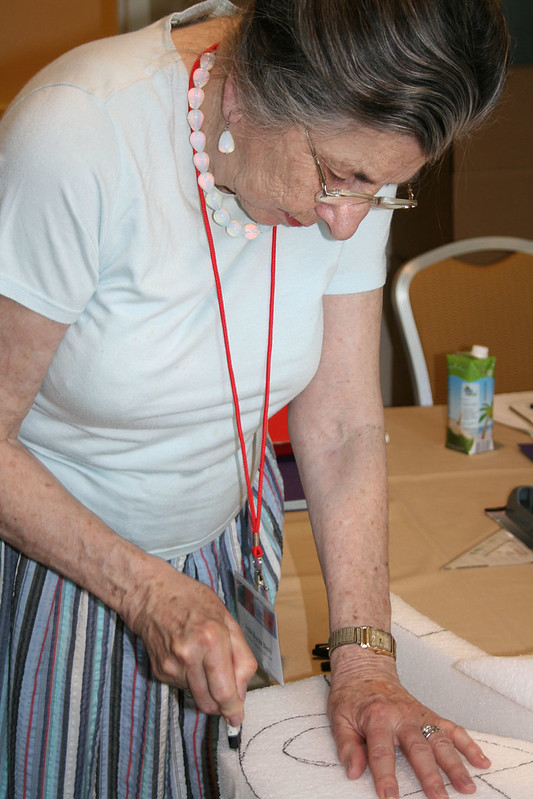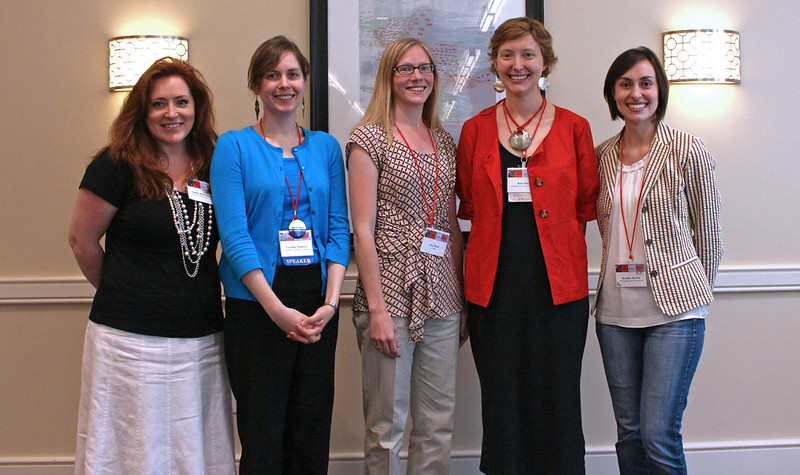
We are pleased to announce the new officers for the Emerging Conservation Professionals Network for the 2015-2016 term. The new and returning officers are very grateful to all the outgoing officers who have worked so hard in their 2014-2015 term: Heather Brown, Laura Neufeld, Ayesha Fuentes, Amy Hughes, and especially our out-going chair, Megan Salazar-Walsh. We wish you the best and hope to see you involved with future AIC and ECPN activities!
Meet the 2015-2016 ECPN Officers:
Fran Ritchie, Chair
Fran graduated with a BA in Art Conservation and Anthropology from the University of Delaware (2006), an MA in Museum Anthropology from Columbia University (2009), and an MA and CAS from the Buffalo State College Program in Art Conservation (2013) with a specialization in objects. She completed pre-program jobs and internships at Biltmore Estate in Asheville, NC, Patronato Panama Viejo in Panama City, Panama, and the American Museum of Natural History in New York. Her Third Year Graduate Internship at the Peabody Museum of Archaeology and Ethnology at Harvard University and subsequent Andrew W. Mellon Fellowship at the National Museum of the American Indian solidified an interest in organic materials. Fran is currently a Project Conservator at the American Museum of Natural History working on a grant-funded project researching dyes used in recoloring faded taxidermy. After serving as Communications Co-Officer (2013-2014) and Professional Education & Training Co-Officer (2014-2015), she is now ECPN Chair (2015-2016).
Michelle Sullivan, Vice Chair
Michelle graduated with a BA in Art History and Studio Art from the University of California at Santa Barbara (2005). In August, she will earn an MS and CAS from the Winterthur/University of Delaware Program in Art Conservation (2015), specializing in works on paper with a minor concentration photographic materials. Michelle has completed internships at the J. Paul Getty Museum, Smithsonian American Art Museum, and the National Gallery of Art. She will return to the Getty in September as a post-graduate fellow in the Department of Old Master drawings. Previously, Michelle has served as ECPN Regional Liaison to Southern California (2011-12), Graduate Program Liaison to the University of Delaware (2012-14), and Professional Education and Training Co-officer (2013-15).
Jessica Walthew, Professional Education and Training, Co-officer
Jessica holds a BA in Art History and Biology from Williams College (2009), with an MA in the History of Art and Archaeology with an Advanced Certificate in Conservation from The Conservation Center, Institute of Fine Arts, New York University (2015). She has worked in the conservation departments of the American Museum of Natural History, Brooklyn Museum, The Frick Collection, the Philadelphia Museum of Art, and the Penn Museum. Her research interests include theory and practice in archaeological and ethnographic conservation, best practices in documentation, and technical research in art history and archaeology. In fall 2015 she will begin an Andrew W. Mellon Fellowship at The Metropolitan Museum of Art researching the intersection of textiles and objects conservation practices in the Department of Arts of Africa, Oceania and the Americas.
Elyse Driscoll, Professional Education and Training Co-officer
Elyse is Assistant Paper Conservator at the Brooklyn Museum. She holds a BFA in Drawing from Pratt Institute and an MA and CAS in Art Conservation with a specialization in works on paper from Buffalo State College (2014). Her training included internships at the Morgan Library & Museum, the Metropolitan Museum of Art, the Museum of Fine Arts, Boston, and the Williamstown Art Conservation Center. This is Elyse’s first year serving ECPN.
Alexa Beller, Communications Co-officer
Alexa holds a BA in History, a BFA in Painting, and a minor in Chemistry from the University of Illinois Urbana-Champaign (2013). She is currently a second year graduate fellow at the Winterthur/University of Delaware Program in Art Conservation and is focusing her studies on paintings conservation. Alexa has had pre-program jobs and internships at the University of Illinois Library Conservation Unit, The Spurlock Museum, the Chicago History Museum, in the private paintings conservation practice of Ria German-Carter, and Architectural Conservation Inc as well as a graduate internship at the Western Center for the Conservation of Fine Art. She previously served as the ECPN Regional Liaison for the San Francisco Bay Area (2013-2014).
Rebecca Gridley, Communications Co-officer
Rebecca holds a BA in Art History from Yale University (2009). She is entering her third year at The Conservation Center of the Institute of Fine Arts, New York University, where she is specializing in objects conservation. Prior to graduate school, she worked for three years as a National Account Manager at The Conservation Center in Chicago and completed pre-program work at Art Conservation Group and Cranmer Art Group, private practices in New York with respective specialties in objects conservation and modern and contemporary paintings conservation. She recently completed an internship at The Museum of Modern Art, and is interning at The Frick Collection this summer. This is Rebecca’s first year serving ECPN.
Anne Schaffer, Outreach Co-officer
Anne Schaffer earned her BA in Visual Art and Chemistry from Bennington College (2011), with additional coursework at Studio Art Centers International in Florence, Italy. She has held pre-program internships at the Fine Arts Museums of San Francisco, Williamstown Art Conservation Center, Higgins Armory Museum, and Baltimore Museum of Art, in addition to work in private practice. Anne completed a graduate summer internship in 2014 at ICA – Art Conservation in Cleveland, OH and is spending the summer of 2015 at the Menil Collection in Houston, TX before beginning her third year graduate fellowship at the Philadelphia Museum of Art. Anne expects to earn her MA and CAS in Art Conservation with a paintings specialization from Buffalo State College in 2016. This is her second year serving as an Outreach Co-Officer for ECPN.
Kimi Taira, Outreach Co-officer
Kimi has a BA in Studio Art from Mills College (2008) and is finishing her degree with the Winterthur/University of Delaware Program in Art Conservation, specializing in paper with a minor in library and archival materials. Her interests include conservation ethics, community-centered preservation initiatives, and the relationship between tangible and intangible heritage. She has worked various conservation positions and internships at Zukor Art Conservation, the Asian Art Museum of San Francisco, the Conservation Center for Art and Historic Artifacts, and the Museum of New Zealand Te Papa Tongarewa. She is completing her third-year internship at the Cleveland Museum of Art and will continue as their Kress Fellow. This is Kimi’s first year serving ECPN.






